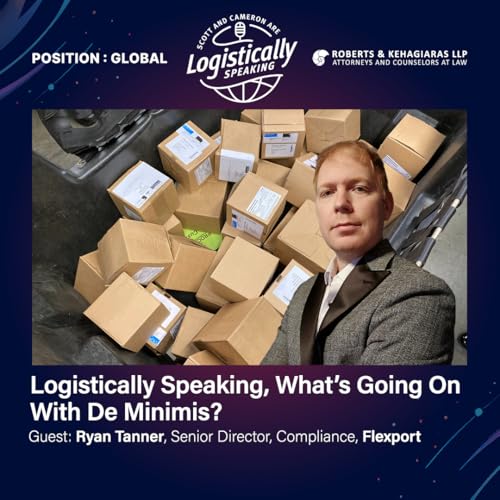In this episode of Logistically Speaking, co-hosts Scott Case and Cameron Roberts sit down with Paul Bingham, Director of Global Intelligence and Analytics, Transportation Consulting for S&P Global Market Intelligence, to dissect the potential impact of sweeping new tariff proposals following the November 2024 U.S. presidential election. The discussion centers on how proposed tariffs - ranging from a global 10% import duty to targeted levies of up to 200% on specific trading partners - could reshape international commerce and supply chains. Bingham reveals how S&P Global has recalibrated their economic models to account for these dramatic policy shifts, offering insights into what businesses might expect in 2025 and beyond.
The conversation explores the ripple effects these tariff changes could have throughout the global economy, from consumer prices to fuel costs, and examines how different sectors might adapt to this new trade landscape. Cameron details the means by which the administration can promulgate some of these proposals on day one based on the power vested in the Executive Branch by Congress.
Bingham shares detailed analysis on how these policies could impact critical trade relationships, particularly with Mexico and Canada under USMCA, while also addressing concurrent challenges in global shipping, including Red Sea disruptions, evolving air cargo capacity, and the ongoing transformation of international supply chains. The discussion further examines the intersection of tariff policy with other key economic factors, including the CHIPS Act implementation, de minimis trade rules, and the potential responses from BRICS nations.
About Paul Bingham:
Paul Bingham serves as the Director of Global Intelligence and Analytics, Transportation Consulting for S&P Global Market Intelligence. With decades of experience in economic and transportation analysis, Bingham is a recognized expert in global trade patterns and supply chain economics. He regularly provides strategic guidance to both public and private sector clients on transportation and trade policy issues. His work at S&P Global includes leading teams that develop economic forecasts and analyze global trade trends, helping organizations navigate complex international market dynamics and policy changes. Bingham is a frequent speaker at industry conferences and events, including the recent WESCCON gathering of customs brokers and freight forwarders.
Relevant Links:
USMCA (United States-Mexico-Canada Agreement) https://ustr.gov/usmca
S&P Global Market Intelligence https://www.spglobal.com/marketintelligence/en/
International Emergency Economic Powers Act (IEEPA) https://home.treasury.gov/policy-issues/financial-sanctions/sanctions-programs-and-country-information
CHIPS and Science Act https://www.commerce.gov/chips
Section 232 Trade Investigations https://www.bis.doc.gov/232
De Minimis Trade Rules & Section 321 https://www.cbp.gov/trade/basic-import-export/e-commerce/section-321-value-increases
Federal Maritime Commission (FMC) https://www.fmc.gov/
TIACA (The International Air Cargo Association) https://www.tiaca.org/
Suez Canal Alternative Routes https://www.suezcanal.gov.eg/
BRICS Economic Coalition https://infobrics.org/
 56 min
56 min 51 min
51 min 59 min
59 min Jan 24 202551 min
Jan 24 202551 min 45 min
45 min 51 min
51 min 52 min
52 min Aug 7 202447 min
Aug 7 202447 min
